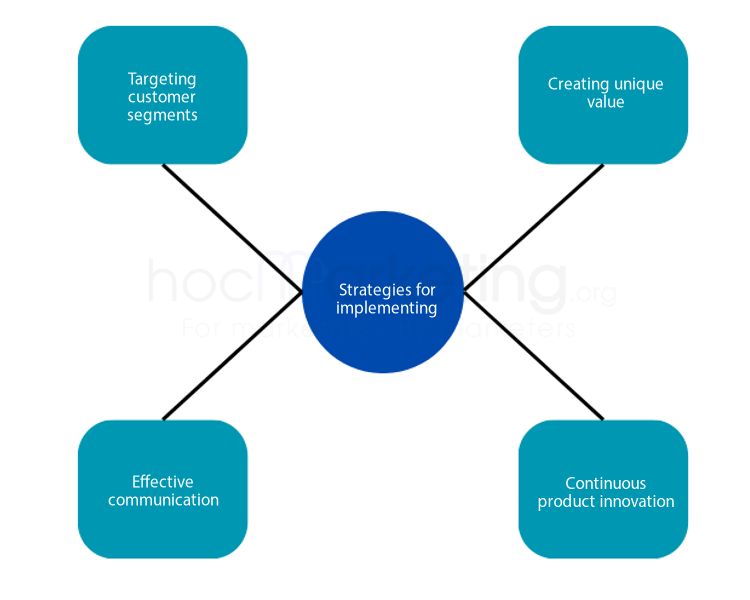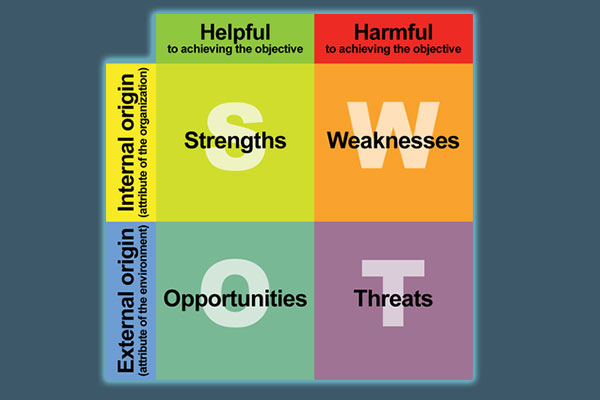
What is Product-based differentiation? Product-based differentiation methods in Marketing

Learn about product-based differentiation and its importance in marketing. Discover the types of differentiation, strategies for implementation, and challenges. Find successful examples and optimize your marketing efforts.
In this blog post, we will explore what product-based differentiation is, why it is essential in marketing, the various types of product-based differentiation, strategies for implementing it, and some of the challenges businesses face when attempting to differentiate their products. We will also provide examples of successful product-based differentiation to help you understand how businesses have effectively implemented this strategy. So, let's dive in!
1. What is product-based differentiation?
Product-based differentiation refers to the process of creating distinctions between products or services offered by a company, in order to make them more attractive to customers. This differentiation can be based on various factors such as quality, design, features, performance, and style. The primary objective of product-based differentiation is to make a product stand out from the competition, and to create a unique selling proposition that appeals to specific customer segments. This approach is especially important in today's highly competitive business environment, where customers have a wide range of choices and are constantly bombarded with marketing messages. By creating a differentiated product, companies can improve their market share, increase customer loyalty, and achieve greater profitability. In the following sections, we will explore the different types of product-based differentiation, strategies for implementing them, and examples of successful implementation.2. Importance of product-based differentiation in marketing
Product-based differentiation is a crucial aspect of marketing that enables companies to distinguish their offerings from competitors and attract customers. In today's highly competitive business environment, it is important for companies to stand out in the market and provide unique value to customers. Product-based differentiation is an effective way to achieve this goal by creating a distinct identity for the product that sets it apart from the rest. By offering unique features, quality, and design, companies can cater to different customer needs and preferences, leading to increased customer loyalty and brand recognition.Moreover, product-based differentiation enables companies to charge premium prices for their offerings, which can help increase profitability and revenue. For example, Apple is known for its premium pricing strategy based on its product differentiation, which has helped the company maintain its position as a market leader in the technology industry. Product-based differentiation also helps companies to mitigate the impact of price competition, as customers are willing to pay more for unique and valuable products.
In addition, product-based differentiation can help companies to establish a competitive advantage in the market, which is essential for long-term success. By continuously innovating and improving their products, companies can differentiate themselves from their competitors and maintain their market position. This is particularly important in industries where product life cycles are short, and new products are introduced frequently.
Overall, product-based differentiation is an essential marketing strategy that helps companies to create unique value for customers, increase profitability, and establish a competitive advantage. While there are challenges associated with implementing this strategy, such as cost implications and competitive pressures, companies that are able to successfully differentiate their offerings can reap significant rewards.
3. Types of product-based differentiation
Product-based differentiation can be achieved through various methods. In this section, we will discuss the different types of product-based differentiation that companies use to stand out in the market. The five main types of product-based differentiation are quality differentiation, design differentiation, feature differentiation, performance differentiation, and style differentiation.Quality differentiation is one of the most common types of product-based differentiation. This type of differentiation focuses on the quality of the product and its components, including the materials used, the manufacturing process, and the finished product. Companies that use quality differentiation aim to provide customers with products that are superior in terms of durability, reliability, and performance.
Design differentiation is another type of product-based differentiation that focuses on the visual and aesthetic aspects of the product. This type of differentiation aims to create products that are visually appealing and unique. Companies that use design differentiation invest heavily in product design and packaging to create a distinctive look and feel for their products.
Feature differentiation is a type of product-based differentiation that focuses on the product's unique features and capabilities. Companies that use feature differentiation aim to provide customers with products that offer unique or advanced features that are not available in competing products. This type of differentiation can be particularly effective in highly competitive markets where customers are looking for products that offer something new and innovative.
Performance differentiation focuses on the product's ability to perform specific functions or tasks. Companies that use performance differentiation aim to provide customers with products that are superior in terms of speed, accuracy, and efficiency. This type of differentiation is often used in industries where performance is critical, such as technology or automotive industries.
Finally, style differentiation is a type of product-based differentiation that focuses on the product's appearance and style. This type of differentiation is often used in industries where fashion and trends play a significant role, such as the beauty or fashion industries. Companies that use style differentiation aim to provide customers with products that are stylish and fashionable, often using celebrity endorsements or collaborations with fashion designers to create a unique look and feel for their products.
Quality differentiation
Quality differentiation refers to the process of creating a product that is superior in terms of quality compared to other products in the market. This type of differentiation is achieved by focusing on the quality of materials used, superior technology, and superior craftsmanship. Quality differentiation is an effective method of differentiation as it appeals to customers who are looking for products that are durable, reliable, and of superior quality.In order to achieve quality differentiation, companies must focus on the quality of their product from the design stage to the manufacturing stage. This requires investing in high-quality raw materials, advanced technology, and skilled labor. Companies must also ensure that their products meet or exceed industry standards and regulations.
One example of a company that has successfully implemented quality differentiation is Apple. Apple is known for producing products that are of superior quality compared to other products in the market. The company invests heavily in research and development to ensure that their products are technologically advanced, durable, and reliable. Apple's focus on quality has helped the company to create a loyal customer base that is willing to pay a premium price for their products.
In conclusion, quality differentiation is an effective method of differentiation as it appeals to customers who are looking for products that are durable, reliable, and of superior quality. To achieve quality differentiation, companies must focus on the quality of their product from the design stage to the manufacturing stage and invest in high-quality raw materials, advanced technology, and skilled labor. Successful examples of quality differentiation include Apple, which is known for producing products that are of superior quality compared to other products in the market.
Design differentiation
Design differentiation involves creating unique and appealing visual elements for a product, such as its shape, color, packaging, and branding. This type of differentiation can be especially effective in industries where customers place a high value on aesthetics, such as fashion, beauty, and electronics. By creating a visually distinctive product, companies can make their offerings stand out from competitors and appeal to consumers' desire for self-expression and individuality. For example, Apple's sleek and minimalist design aesthetic has become a hallmark of its products, helping to differentiate them in the crowded tech market.Design differentiation can also be used to signal quality or functionality. For instance, a product with a sturdy, ergonomic design might be perceived as more durable and reliable than one with a flimsy or uncomfortable design. Likewise, a product with an innovative or intuitive design might be seen as more functional or user-friendly than one with a generic or confusing design. By leveraging design to communicate these attributes, companies can differentiate their products based on perceived value rather than just price or features.
However, design differentiation can also be challenging to execute. Creating a truly unique and appealing design requires significant investment in research, development, and testing, as well as skilled designers and engineers. Moreover, design trends and consumer preferences can be fickle and constantly evolving, making it difficult to stay ahead of the curve. Finally, design differentiation can be vulnerable to imitation or replication by competitors, especially in industries where intellectual property protections are weak. Despite these challenges, design differentiation remains a powerful tool for companies looking to set themselves apart in competitive markets.
Feature differentiation
Feature differentiation is a product-based differentiation method that involves distinguishing a product based on the specific features it offers. This type of differentiation focuses on offering unique features that competitors do not have or cannot replicate easily. A feature can be a physical attribute of the product or a functional aspect that enhances its performance.In order to implement feature differentiation, companies need to conduct market research to identify the features that customers value the most. This can involve analyzing customer feedback, conducting surveys, or observing customer behavior. Once the features have been identified, companies need to ensure that they are integrated into the product in a meaningful way.
One way to implement feature differentiation is by offering a wider range of features than competitors. This can involve adding new features or improving existing ones. For example, a smartphone manufacturer may offer a better camera, longer battery life, or faster processing speed than its competitors.
Another strategy is to focus on a specific feature that is highly valued by a particular customer segment. For instance, a car manufacturer may differentiate its product by offering advanced safety features that are particularly important to families with young children.
Feature differentiation can be challenging as competitors may quickly replicate features or offer similar features at a lower cost. To maintain its competitive advantage, a company may need to continuously innovate and update its features to stay ahead of the competition. Effective communication of the unique features is also crucial to ensure that customers understand the value proposition of the product.
Performance differentiation
Performance differentiation is another product-based differentiation strategy that companies can use to stand out from their competitors. This approach involves creating products that outperform those of competitors in terms of speed, accuracy, efficiency, reliability, and other factors. For example, a laptop manufacturer may differentiate its products by offering faster processors, longer battery life, and better graphics cards than its competitors. Similarly, a car manufacturer may differentiate its models by offering better fuel efficiency, more horsepower, and more advanced safety features.To implement performance differentiation successfully, companies must conduct extensive research and development to identify the key performance factors that matter most to their target customers. They must also invest in the latest technologies and manufacturing processes to ensure that their products can meet or exceed customer expectations. Furthermore, they must constantly monitor and improve their products' performance to stay ahead of the competition.
One of the main advantages of performance differentiation is that it can create a strong competitive advantage for companies. By offering superior performance, companies can appeal to customers who demand the best quality and are willing to pay a premium for it. Additionally, performance differentiation can help companies establish a reputation for innovation and excellence, which can be difficult for competitors to replicate.
However, there are also some challenges associated with performance differentiation. For example, it can be costly to invest in research and development and the latest technologies. Additionally, competitors may be able to catch up quickly by copying or improving upon a company's performance features. Finally, managing customer expectations can be challenging, as customers may have high expectations for performance and may be disappointed if a product does not meet their expectations.
Overall, performance differentiation can be an effective product-based differentiation strategy for companies that are willing to invest in research and development and stay ahead of the competition. By offering superior performance, companies can appeal to customers who demand the best and establish a strong competitive advantage.
Style differentiation
Style differentiation refers to the unique aesthetic appearance of a product, which sets it apart from competitors. Style differentiation can be achieved through the use of distinctive colors, shapes, and packaging design. This type of differentiation is particularly effective in industries where consumers place a high value on the overall look and feel of a product, such as fashion, cosmetics, and home décor.One example of successful style differentiation is Apple's iPhone. The sleek and minimalist design of the iPhone, coupled with its distinctive silver color and iconic apple logo, has helped the product to stand out in a crowded market. Another example is Coca-Cola's iconic bottle shape, which has become synonymous with the brand and instantly recognizable to consumers around the world.
However, achieving effective style differentiation can be challenging. It requires a deep understanding of consumer preferences and an ability to create a unique look and feel that resonates with target audiences. Additionally, style differentiation can be costly to implement, requiring significant investments in design and branding.
To successfully implement style differentiation, companies must focus on creating a consistent and compelling visual identity across all aspects of their product, from packaging to advertising campaigns. They must also continually innovate and update their product design to stay ahead of competitors and maintain consumer interest. Overall, style differentiation can be a powerful tool for companies looking to establish a strong brand identity and stand out in a crowded market.
4. Strategies for implementing product-based differentiation
To successfully implement product-based differentiation, businesses must adopt strategies that set their products apart from competitors. First, targeting specific customer segments is essential. By understanding the unique needs and preferences of a target market, businesses can tailor their products to meet those needs and create a stronger differentiation.Secondly, creating a unique value proposition can help a business showcase its competitive advantage. This means identifying what sets the product apart from others in the market and communicating it effectively to customers. A strong value proposition can help attract customers who are looking for something different or better than what is currently available.
Continuous product innovation is also crucial for maintaining differentiation. Businesses must stay ahead of the curve by introducing new and improved features, designs, or performance capabilities. This not only attracts new customers but also helps retain existing ones who value innovation and change.
Lastly, effective communication of differentiation is key. Businesses must clearly and consistently communicate the unique features and benefits of their products to target customers. This can be achieved through advertising, social media, or other marketing channels. By doing so, businesses can build a strong brand identity and a loyal customer base.
However, there are also challenges in implementing product-based differentiation. One of the main challenges is cost implications, as introducing new features or designs can be expensive. Additionally, businesses must also navigate competitive pressures from rivals who may quickly copy or improve upon the differentiated features. Managing customer expectations can also be challenging, as they may have high expectations for the product based on the marketing messaging.
Despite these challenges, there are many successful examples of product-based differentiation. Companies like Apple, Tesla, and Nike have successfully differentiated their products through innovative features, designs, and quality. By adopting effective strategies and overcoming challenges, businesses can successfully differentiate their products and gain a competitive edge in the market.
Targeting specific customer segments
One of the crucial strategies for implementing product-based differentiation in marketing is targeting specific customer segments. This involves identifying the unique needs, preferences, and characteristics of a particular group of customers and developing a product that caters to their specific requirements. By focusing on a specific market segment, companies can create a product that stands out from competitors and addresses the specific needs of a particular group of customers. This can help to increase customer loyalty and drive sales growth.To effectively target specific customer segments, companies need to conduct market research to understand the needs and preferences of their target audience. This involves gathering data on factors such as age, gender, income level, lifestyle, and buying behavior. Companies can then use this information to create a product that meets the specific needs and wants of their target audience. For example, a company targeting young, tech-savvy customers may develop a product with advanced features and sleek design that appeals to this demographic.
Another key aspect of targeting specific customer segments is creating a marketing message that resonates with the target audience. Companies need to develop a clear and compelling value proposition that communicates the unique benefits of their product to their target audience. This involves highlighting the key features and benefits of the product and demonstrating how it addresses the specific needs of the target audience. Effective communication of differentiation is critical in ensuring that customers understand the unique value of the product and are motivated to make a purchase.
Overall, targeting specific customer segments is a critical strategy for implementing product-based differentiation in marketing. By developing a product that meets the specific needs and wants of a particular group of customers, companies can effectively differentiate themselves from competitors and drive sales growth. However, this strategy also involves challenges such as cost implications and competitive pressures, which must be carefully managed to ensure the success of the differentiation strategy.
Creating a unique value proposition
Creating a unique value proposition is a crucial strategy for implementing product-based differentiation in marketing. A value proposition is a statement that describes the unique benefit that a product or service provides to its customers, setting it apart from competitors. It is important to create a value proposition that resonates with the target market and addresses their specific needs and desires.To create a unique value proposition, companies must first identify their target market and understand their needs. Companies can conduct market research to gain insights into their target audience and develop a deep understanding of their preferences and pain points. Once the target market has been identified, companies can create a value proposition that speaks directly to their needs and preferences.
Another important aspect of creating a unique value proposition is to focus on the benefits that the product or service provides, rather than the features. Customers are more interested in the benefits that a product provides, rather than the technical specifications. By focusing on the benefits, companies can create a more compelling value proposition and differentiate themselves from competitors.
In addition to identifying the target market and focusing on benefits, companies must also ensure that their value proposition is unique and memorable. A unique value proposition can be created by offering a unique product or service, or by providing a unique customer experience. Companies can also differentiate themselves by offering a guarantee or a unique pricing strategy.
Overall, creating a unique value proposition is a critical strategy for implementing product-based differentiation in marketing. It ensures that the product or service stands out from competitors and resonates with the target market. By focusing on the target market, benefits, and uniqueness, companies can develop a compelling value proposition that drives sales and fosters brand loyalty.
Continuous product innovation
Product-based differentiation is a crucial aspect of marketing that helps businesses stand out in a crowded marketplace. One strategy for implementing product-based differentiation is through continuous product innovation. This involves consistently improving and refining existing products or introducing new products to meet changing customer needs and preferences. By doing so, businesses can maintain a competitive edge and keep customers engaged and loyal.Continuous product innovation requires a deep understanding of customer needs and preferences, as well as an ability to anticipate changes in the market. It involves investing in research and development to identify new features, technologies, or materials that can be incorporated into existing products or used to create new ones. This can be a time-consuming and expensive process, but it is essential for businesses that want to stay ahead of the competition.
In addition to creating new products or improving existing ones, continuous product innovation also involves monitoring customer feedback and making adjustments as necessary. This can help businesses identify areas where their products are falling short and make changes to address these issues. By staying responsive to customer needs and preferences, businesses can continue to differentiate themselves from their competitors and build strong, long-lasting relationships with their customers.
Overall, continuous product innovation is a powerful strategy for implementing product-based differentiation. By consistently improving and refining their products, businesses can stay ahead of the competition and meet the changing needs of their customers. While this approach can be challenging, it is also essential for businesses that want to succeed in today's fast-paced, constantly evolving marketplace.
Effective communication of differentiation
To successfully differentiate a product, it is not enough to simply have unique features or qualities. The differentiation must be effectively communicated to the target market. This involves creating a strong brand identity and messaging that highlights the unique value proposition of the product. One effective way to communicate differentiation is through advertising and other marketing channels. For example, a company can use social media platforms to showcase the unique features and benefits of their product. Another strategy is to use influencer marketing, where a well-known personality promotes the product to their followers. Additionally, packaging and labeling can also be used to differentiate the product and communicate its unique value proposition. Overall, effective communication of differentiation is crucial for a product to stand out in a crowded market and attract the attention of potential customers.5. Challenges in implementing product-based differentiation
Implementing product-based differentiation in marketing is not without its challenges. In this section, we will discuss some of the common challenges faced by businesses when trying to differentiate their products from those of their competitors. These challenges include cost implications, competitive pressures, and managing customer expectations.One of the biggest challenges of product-based differentiation is the cost implications involved. Developing and manufacturing products with unique features, designs or performance capabilities can be expensive, especially for small businesses. The cost of research and development, as well as the cost of sourcing high-quality materials and components, can add up quickly. This can make it difficult for businesses to justify the investment, especially if they are not sure they will see a return on their investment.
Another challenge is the competitive pressures that businesses face. With so many products available in the market, it can be difficult to differentiate oneself from the competition. This is particularly true in industries where there are many established players with well-known brands and loyal customer bases. Businesses must find ways to stand out from the crowd while also delivering on customer expectations.
Managing customer expectations is another challenge when implementing product-based differentiation. When businesses create products with unique features, designs, or performance capabilities, they must also educate customers on how to use these products and what benefits they offer. This can be a challenge, especially if customers are not familiar with the technology or innovation involved. Businesses must also ensure that their products meet customer expectations in terms of quality, performance, and value for money.
In conclusion, while product-based differentiation is an effective marketing strategy, it is not without its challenges. Businesses must be prepared to invest in research and development, navigate competitive pressures, and manage customer expectations to successfully implement this strategy. By doing so, they can differentiate themselves from their competition and create products that are valuable to their target customers.
Cost implications
Product-based differentiation can be a highly effective marketing strategy, but it is not without its challenges. One of the primary concerns when implementing product-based differentiation is the cost implications. Creating high-quality products with unique features and designs often requires significant investment in research and development, as well as manufacturing processes. This can result in higher production costs, which may need to be passed on to consumers through higher prices.Additionally, companies may need to invest in marketing and advertising campaigns to effectively communicate the value of their differentiated products to consumers. This can also be costly, particularly if the company is targeting a niche market with specific needs and preferences.
Another cost consideration is the need to continually innovate and improve products to stay ahead of the competition. This requires ongoing investment in research and development, as well as a willingness to take risks and experiment with new approaches.
Despite these challenges, many companies have successfully implemented product-based differentiation strategies, often by targeting specific customer segments and creating a unique value proposition that resonates with their target audience. By effectively communicating the benefits of their products and investing in ongoing innovation, these companies have been able to differentiate themselves from competitors and build strong brand loyalty among consumers.
Competitive pressures
In a highly competitive market, businesses face several pressures that can make it challenging to implement product-based differentiation strategies. One of the primary challenges is the pressure to keep up with competitors who may offer similar products or services. Businesses need to continuously analyze their competitors' offerings and ensure that they are offering something unique and valuable to their customers. Failure to differentiate can result in losing market share and revenue to competitors.Another challenge is the pressure to balance the cost of differentiation with the potential benefits. Implementing product-based differentiation strategies can be costly, especially if it requires significant investment in research and development, design, or production processes. Businesses need to ensure that the cost of differentiation is justified by the potential increase in revenue and profits.
Additionally, businesses need to manage customer expectations when implementing product-based differentiation strategies. Customers may have different preferences and expectations, and businesses need to ensure that their differentiation strategies appeal to their target customers. Failure to meet customer expectations can result in negative reviews and loss of customers.
Overall, businesses need to carefully assess the competitive pressures they face and develop effective strategies to differentiate their products and services. They need to balance the cost of differentiation with the potential benefits and ensure that their differentiation strategies meet their target customers' expectations. Successful implementation of product-based differentiation strategies can help businesses stand out in a crowded market and drive revenue growth.
Managing customer expectations
To successfully implement product-based differentiation, managing customer expectations is crucial. Customers expect the product to deliver the promised benefits and meet their needs. Therefore, companies need to ensure that their product-based differentiation strategies align with customer expectations. Companies can conduct market research to understand customer preferences and expectations. This information can then be used to develop products with features and attributes that meet customer needs.Another important aspect of managing customer expectations is setting realistic expectations. Companies need to be transparent about what their products can and cannot do. Over-promising and under-delivering can lead to customer dissatisfaction and negative reviews. Therefore, it is essential to communicate the product's capabilities effectively and provide clear information about any limitations.
Additionally, companies need to ensure that their products are easy to use and understand. Customers are more likely to purchase products that are user-friendly and intuitive. Therefore, companies need to invest in product design and user experience to ensure that their products are easy to use and understand.
In summary, managing customer expectations is critical to the success of product-based differentiation. Companies need to align their product-based differentiation strategies with customer preferences and expectations, set realistic expectations, and invest in product design and user experience to ensure that their products are user-friendly and intuitive.
6. Examples of successful product-based differentiation
Product-based differentiation has been used successfully by many companies to gain a competitive advantage in the market. One such example is Apple, which has differentiated its products through design, features, and performance. The company's iPhone series, for instance, is known for its sleek design, user-friendly interface, and cutting-edge technology. Another example is Nike, which has differentiated its products through quality and style. The company's athletic shoes are known for their durability, comfort, and unique designs.Other companies that have successfully implemented product-based differentiation include Coca-Cola, which has differentiated its products through branding and packaging, and BMW, which has differentiated its products through performance and design. Similarly, companies such as Samsung, Toyota, and Amazon have differentiated their products through a combination of quality, features, and innovation.
Successful product-based differentiation requires a deep understanding of customer needs and preferences, as well as a commitment to continuous product innovation. It also requires effective communication of the differentiation to customers, through advertising, branding, and other marketing initiatives.
Overall, product-based differentiation can be a powerful tool for companies looking to stand out in a crowded market. By focusing on quality, design, features, and performance, companies can create unique value propositions that resonate with customers and drive sales. However, implementing product-based differentiation requires careful planning and execution, as well as a willingness to invest in product development and marketing initiatives.















